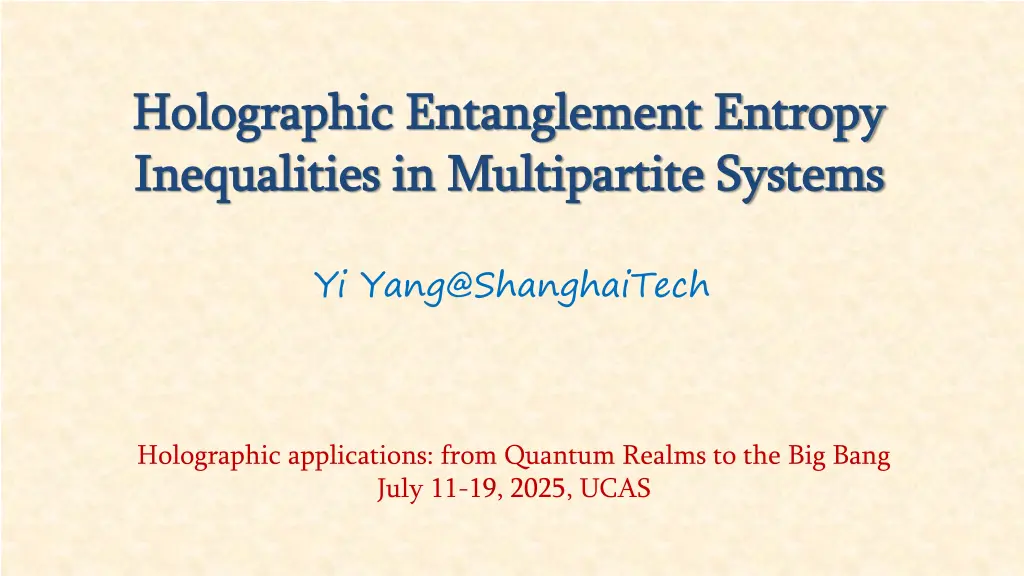
Quantum Entanglement in Holography
Explore the fascinating world of quantum entanglement and holography, delving into concepts like entanglement entropy, inequalities, and multipartite systems. Discover the significance of strong subadditivity and the Ryu-Takayanagi surface in this cutting-edge field of study.
Download Presentation

Please find below an Image/Link to download the presentation.
The content on the website is provided AS IS for your information and personal use only. It may not be sold, licensed, or shared on other websites without obtaining consent from the author. If you encounter any issues during the download, it is possible that the publisher has removed the file from their server.
You are allowed to download the files provided on this website for personal or commercial use, subject to the condition that they are used lawfully. All files are the property of their respective owners.
The content on the website is provided AS IS for your information and personal use only. It may not be sold, licensed, or shared on other websites without obtaining consent from the author.
E N D
Presentation Transcript
Holographic Entanglement Entropy Holographic Entanglement Entropy Inequalities in Multipartite Systems Inequalities in Multipartite Systems Yi Yang@ShanghaiTech Holographic applications: from Quantum Realms to the Big Bang July 11-19, 2025, UCAS
Motivations Motivations Entanglement entropy inequality (HEI) Strong subadditivity for black hole information paradox Quantum information, quantum transportations It is a challenge to prove multipartite HEIs in QFT Holography offers a geometric approach
Entanglement Entropy Entanglement Entropy Hilber space of a bipartite system: 12= 1 2 Density matrix of a quantum state: ?12= | 12 12| Reduced density matrix: ?1= Tr2?12 Entanglement entropy: ?1= Tr ?1ln?1
Subadditivity (SA) Subadditivity (SA) ?1+ ?2 ?12 1 1 1 2 2 2
Holographic Entanglement Entropy Holographic Entanglement Entropy Ryu-Takayanagi surface ? ????( ?) 4?? ??= min ? Homology ? Divergence
Holographic SA Holographic SA ?1= ?[11] ?1+ ?2 ?12 ?2= ?[22] ?= ?[11]+ ?[22] ?1,2 ?= ?12+ ?21 ?12 ?,?12 ? ?12= min ?1,2
Entanglement Entropy Inequality Entanglement Entropy Inequality Subadditivity (SA): ?1+ ?2 ?12 Strong Subadditivity (SSA): ?12+ ?23 ?2+ ?123 Monogamy of Mutual Information (MMI): ?12+ ?13+ ?23 ?1+ ?2+ ?3+ ?123
Independent HEI Independent HEI How many HEIs in a ?-partite system? ? = 2: ?1 0, ?2 0, ?12 0, ?1+ ?2 ?12(SA) ? = 3: ?1 0, , ?1+ ?23 ?123, SSA, MMI ? = 4 ?
Entanglement Entropy Cone Entanglement Entropy Cone Extremal rays A balanced HEI is finite A superbalanced HEI is Independent
Questions Questions How many nontrivial independent HEIs in a ?-partite system? ? = 2: SA; ? = 3: SSA, MMI; ? = 4: None! ? = 5,6 ? How to prove a HEI in a ?-partite system?
Tripartite System: Configurations Tripartite System: Configurations ?12+ ?23 ?2+ ?123 ? ?1,2,3 = ?1+ ?2+ ?3= ?11+ ?22+ ?33 ? ?= ?11+ ?23+ ?32 ?1,23 = ?1+ ?23 ? ?= ?22+ ?13+ ?31 ?13,2 = ?2+ ?13 ? ?= ?33+ ?12+ ?21 ?12,3 = ?3+ ?12 ? ?123 = ?13+ ?32+ ?21
Tripartite System: Completed Connected Tripartite System: Completed Connected ?+ ?23 ? ?2+ ?123 ? ?12 ?12+ ?21+ ?23+ ?32 ?[22]+ ?13+ ?32+ ?21 ?12+ ?23 ?[22]+ ?13
Circular Graph Circular Graph
Tripartite System: MMI Tripartite System: MMI ?+ ?13 ?+ ?23 ? ?1+ ?2+ ?3+ ?123 ? ?12 ?12+ ?21+ ?13+ ?31+ ?23+ ?32 ?[11]+ ?[22]+ ?[33]+ ?13+ ?32+ ?21 ?12+ ?23+ ?31 ?[11]+ ?[22]+ ?33
Tripartite System: Clean gaps Tripartite System: Clean gaps 0
4 4- -partite System: Compatible partite System: Compatible ? ?1+ ?3 ?13+ ?31, ? ?2+ ?4 ?24+ ?24 ?13 ?24
Compatible Theorem Compatible Theorem Theorem: For two HEEs ??and ?? , if 1. ? ? = 2. ??and ?? are nonplanar Then, ??and ?? are incompatible.
Allowed Configurations Allowed Configurations Incompatible pairs in a 5-partite system Compatible Completed Connected (CCC) configurations
A HEI in the 5 A HEI in the 5- -partite System partite System ? ? ? ? ? ? ? 2?123 + ?124 + ?125 + ?134 + ?145 + ?235 + ?245 ?+ ?45 ?+ ?1234 ? ? ?+ ?13 ?+ ?14 ?+ ?23 ?+ ?25 ? ?12 +?1235 +?1245 2?13+ ?14+ 2?25+ ?31+ ?41+ ?42+ ?52 2?11+ ?12+ ?[22]+ ?23+ ?33+ ?[44]+ ?45+ ?55
A HEI in the 5 A HEI in the 5- -partite System partite System
Prove a HEI in CCC configurations Prove a HEI in CCC configurations Write the HEI in a CCC configuration Draw its circular graph Balanced condition: the same # of red/blue lines Superbalanced condition: gapless Reduce the circular graph by Clean gaps
Non CCC configurations: Cuts Non CCC configurations: Cuts
Cut Theorem Cut Theorem ? ? ? ??split ?? ? ? ? Theorem: A cut ??? into ?? ? and ?? ? , if ? ,? [?,?] and ? ,? [?,?]. For a ?-partite system, there are total ?2?2 1 cuts in ? 1 12 different levels. For a ?-partite system, there are ?? ? ? cuts in level-?. 2
Dependency Acyclic Graph of Cuts Dependency Acyclic Graph of Cuts ? = 3, 6 cuts 26 17 configurations ? = 4, 20 cuts 220 1570 configurations
Dependency Acyclic Graph of Cuts Dependency Acyclic Graph of Cuts ? = 5, 50 cuts 250 2864048 configurations
Configuration Theorem Configuration Theorem Theorem: If a balanced HEI is valid in CCC configurations, then it is valid in all configurations.
Summary Summary Show the HEI is superbalance (independent) Write the HEI in a CCC configuration Draw its circular graph and prove it by clean gaps All other configurations are valid by the configuration theorem Thank you!
